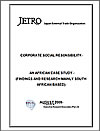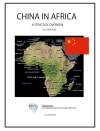 Kraomita Malagasy (Kraoma Sa)
Kraomita Malagasy (Kraoma Sa)
All data are collected in the Fiscal Year of 2008-2009.
Company Profile and History
KRAOMA is a state owned company with an authorized capital of 3.231.560.000 Ariary. KRAOMA exports about 100.000 to 140 000 tons chromium per year. The first chromite lens in Madagascar was discovered in 1948 close to the village of Androfia in the Andriamena region, but mining activity only commenced in 1968. In 1966 COMINA (Compangnie Miniere d’Andriamena) was established to mine chromite with UGINE Company, PECHINEY, COFIMEN, MOKTA, the Societe Francaise de Fonderies et Aciers Electriques (SFAC) and the Malagasy State (20% of the capital) the first shareholders.
In 1975 COMINA was nationalized and re-named "KRAOMITA MALAGASY."
Rock and concentrate production is transported over a distance of approximately 480 km (including 90 km by bituminized road from Brieville to Morarano and 390 km by rail) and then loaded on a ship at the Toamasina port.
KRAOMA’s mines include Bemanevika which was closed in 1972 and only re-opened in 2005. The mine has proven reserves of 2 280 000 tonnes. In 2008 chrome ore production was 145,000Mt from Bemanevika only. The Anengitra Mine has proven reserves of 160 000 tonnes and the Befandriana Area of the mine probable reserves of 465 000 tonnes.
The depleted mine at Ankazotaolana was closed down in 2008.
In Country Location
Rue ANDRIANAIVORAVELONA ZANANY, Antananarivo, Madagascar; tel.: + (261) 20 22 243 04 or + (261) 20 22 334 31; fax: + (261) 20 22 246 54
Services and Products
Its main activity is the extraction, treatment and export of chromium ore
Number of Employees
380 employees
Financial Information
In 2006, output was around 132,330 tonnes, of which 116,290 were exported, the main destinations being China, Japan and Sweden, for a turnover of MGA 28 billion. In 2008 approximately 112,613 tonnes was exported with a trade value of US$32,579,718.
Market Share
Kraoma is the largest and sole producer of chromites, exporting 100% of its output. Kraoma has been Madagascar’s largest producer for almost four decades, but the Rio Tinto/Malagasy government joint-venture company QMM may take over this position in 2009/10. Kraoma also has a monopoly of the marketing of Madagascar's chromium.
Business Objective
“To increase production through improved technologies”
Business Model
In 2007, the government adopted the Madagascar Action Plan (MAP) and KRAOMA derives its strategy from MAP. MAP in broad terms serves as a roadmap to stimulate economic development in a broad-based, integrated program over five years. The brainchild of former President Marc Ravalomanana, MAP consists of eight commitments: responsible governance; connected infrastructure; educational transformation; rural development and a green revolution; health, family and the fight against HIV/AIDS; high-growth economy; cherish the environment; and national solidarity.
The mining industry has been identified as one of the key growth drivers in terms of MAP. The MAP is intended to be an integrated program for development, and mining is critical to the MAP’s other goals of improving infrastructure and nurturing the environment.
Operating for more than 30 years, Kraoma, Madagascar’s only state-owned mining company, takes its role as an engine of economic development seriously. The company has provided schools, a dispensary, churches and a supply of drinking water, among other things. “We have a role as an engine, a role of citizenship, a role of teaching and training. Kraoma is small by comparison, but we aim to act as a model for those (foreign) companies. Do business with Madagascar, but what is the social impact, the positive impact in the long term, says Mejamirado Razafimihary, General Director of Kraoma.
Ownership of Business
Kraoma is 100 percent owned by the government of Madagascar
Benefits Offered and Relations with Government
The Mining Code governs prospecting, exploration, operations, possession, holding, transport, processing and marketing of useful mineral substances found in the soil or subsoil (with the exception of liquid or gaseous hydrocarbons or underground water, which are the subject of separate regulatory frameworks), which are owned by the State. Mining prospection may be freely undertaken within Madagascar, except in protected zones, temporarily reserved classified zones and areas covered by mining permits or by an "exclusive area reservation authorization (AERP)". An AERP is granted for a non-renewable period of three months and gives the exclusive right to prospect and then, where applicable, to request a mining permit with a view to exploration and/or operations within the area covered.
The three types of mining permit are:
an R permit (for prospecting and exploration), valid for five years and renewable twice for three years;
an E permit (for exploitation), valid for 40 years and renewable for several further 20-year periods;
and a PRE permit, exclusively for small-scale operators for prospecting, exploration and operations, valid for eight years, renewable for one or more four-year periods.
Since 2001, Madagascar has had a special framework to encourage large-scale mining investment; since 2005, this framework has been amended to lower the threshold for eligibility from MGA 200 to 50 billion because the results obtained were disappointing.
This special regime gives the right to a series of tax and customs incentives applicable throughout the term of the original mining permit, including: a tax of 25 per cent on the company's profits and those of subcontractors (instead of the standard rate of 35 per cent), which falls to 10 per cent for processing companies and their subcontractors; and in the case of companies whose entire output is exported, the right to import the machinery and equipment covered by the investment project free of VAT.
Investors may also freely convert into foreign currency and transfer the sums needed for their day-to-day operations and, subject to authorization, may transfer capital. They may opt for the regime giving taxation and customs stability while at the same time being eligible for more favourable measures if the State so agrees.
Mining projects under E permits are subject to environmental impact requirements, under the responsibility of the Ministry of the Environment.
Possession and transport of mining products requires registration and a special pass; the mining authorities ensure that exports conform to the declaration made by the exporter. The conformity certificate issued by the mining authorities is required for the export of precious stones and metals and also semi-precious stones.
Madagascar intends to observe the requirements of the Extractive Industries Transparency Initiative, and all its large mining companies have belonged to the Initiative since 2007.
Product Development
Mocoh Resources is looking for a partner to finance and operate the Andriamena chrome ore exploration project in Madagascar held by Kraoma. Mocoh intends to identify and prove additional reserves and reopen the Ankazo open pit closed in December 2007, while leveraging the existing infrastructures (treatment plant, transportation facilities road and train, mining village) for the production phase. Mocoh is a Swiss based oil distribution, logistics, trading and exploration company with a geographical emphasis on Europe, the Middle East, Africa, the former Soviet Union and the Indian Ocean Islands. Mocoh is also involved in resources exploration, currently developing a Gas-to-Power project for the local supply of energy in Madagascar. The management of Mocoh Resources has over 20 years experience working in Madagascar.




